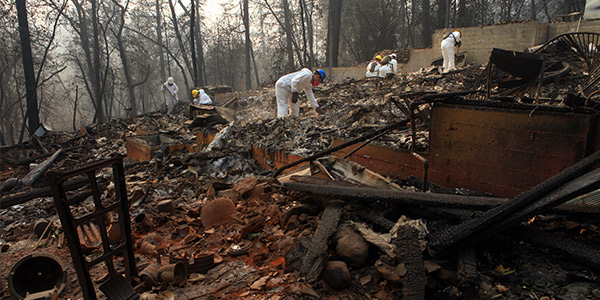By Hudson Sangree
California’s annual wildfire season kicked off last week with high winds, a heat wave and precautionary power shutoffs by Pacific Gas and Electric to thousands of customers.
A wind-driven blaze called the Sand Fire burned 2,500 acres of hilly terrain 60 miles west of Sacramento, and another fire scorched 1,800 acres of dry grasslands in rural Central California. Neither fire caused serious injuries or property damage, but they underscored the threat of wildfires as vegetation begins to dry out after an especially wet winter.
In response to the hot, windy conditions, PG&E turned off power for a day or two for about 1,700 customers in Napa, Solano and Yolo counties near the Sand Fire and for nearly 21,000 in the Sierra Nevada foothills of Yuba and Butte counties. Last year’s Camp Fire, the deadliest and most destructive in state history, ravaged a large part of Butte and leveled the town of Paradise.
Southern California Edison and San Diego Gas & Electric have shut down power before when Santa Ana winds blew. (See Fire Season Becomes Blackout Time in California.)
PG&E first deployed its controversial Public Safety Power Shutoff program last October, nearly a month before the Camp Fire started Nov. 8 — though it did not use the measure in Butte just before that fire ignited.
Power shutoffs are now part of the utilities’ annual wildfire mitigation plans approved by the California Public Utilities Commission. (See California Regulators OK Utility Wildfire Plans.)
A Portland, Ore.-based utility announced Thursday it was adopting a similar measure, suggesting that intentional shutoffs may spread beyond California. The Pacific Northwest has seen its share of devastating wildfires in recent years.
“This measure would only be taken as a last resort to help ensure customer and community safety,” Pacific Power said in a statement. The utility, a subsidiary of PacifiCorp, serves about 764,000 customers in Oregon, Washington and an area of Northern California near the Oregon border.
The National Interagency Fire Center (NIFC) in Boise, Idaho, predicts an active wildfire season in California, the Great Basin and the Pacific Northwest this year because of a “robust grass crop” from winter rains.
“As we go forward into June, those grasses that we see across the landscape are going to dry and cure out … and we’ll see an increase in fire activity especially across California,” said Bryan Henry, assistant program manager of predictive services at the NIFC.
Temperatures soared above 100 degrees Fahrenheit in inland areas during last week’s heat wave. CAISO issued its first “flex alert” of 2019 by calling for residents to voluntarily conserve electricity during peak demand in the late afternoon and evening, when air conditioning use spikes and solar arrays power down.
“Because of widespread heat, the ISO anticipates energy demand reaching a peak of 42,800 MW this evening,” CAISO said in a June 11 news release. “Also, two units with a total generation of 1,260 MW are offline due to mechanical failures. The Flex Alert is being called in response to the high electricity demand and the reduced generation.”
California, which last year mandated greater dependence on renewable energy sources going forward, offset the spike in demand largely with natural gas peaker plants, according to CAISO.



